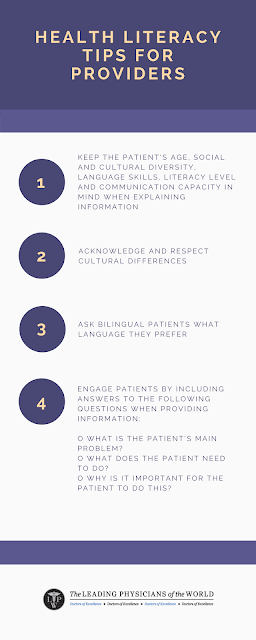Health Literacy Tips for Providers
How can you
be sure your patients understand the health information you pass on to them? By
focusing on health literacy, doctors, nurses and other clinicians can better
help patients comprehend complex health information-something of critical
importance given today’s transformative healthcare environment. The definition of
health literacy is evolving. It used to be about problems or lack of skills
that patients had in medical settings, and it has evolved into looking at the
alignment between the demands and complexities of health care systems with the
needs and abilities of patients, families, caregivers and anyone receiving
health information.Here are the practical health literacy tips for providers.
1.
Don’t panic
First of all,
literacy is very complex. All people have a range of literacy
skills and processes. Only a few of these are captured by any assessment.
Consider smart phones. They’re everywhere, and they require reading and
writing. If your patient can use a smart phone, they certainly have some
level of literacy. Even people who are labeled as ‘illiterate’ have
sophisticated ways of reading a text or image, keeping track of items, and
estimating and calculating. So don’t panic.
2.
Communicate
clearly
The first
step in health literacy involves clear communication, which can move beyond
traditional methods of talking and writing. Health literacy is fully effective
when providers and patients truly understand one another. The essence of health
literacy has to do with mutual understanding. Metaphors, analogies, music and
stories are all communication methods that can be implemented to help patients
understand and relate to health issues. But the most important piece of the
communication puzzle is keeping language simple and concise.
3.
Don’t let a
label ‘stick’ to your patient
Researchers
are certain about the fact that a health literacy assessment score is not a
proxy for a patient’s education level. But it can still wind up being
treated that way. Don’t fall into the trap of thinking your patient is
uneducated, or somehow deficient, if they struggle with reading or writing.
Approach your patient as someone who uses language in sophisticated
ways in their everyday life. Speak to them with this assumption in mind.
You’ll feel less disconnected from your patient. You’ll be able to focus
on the task at hand, rather than some perceived deficiency.
4.
Confirm
understanding
After
information is evidently communicated, the next step is confirmation of
knowledge. If there was one more thing clinicians could do to improve health
literacy, it should be to confirm understanding. It’s essential to confirm the
understanding really happened. You can communicate information, but it won’t be
of any use unless the patient truly understands what they are being
told.Doctors and nurses may be familiar with concepts known as teaching back
and demonstration/re-demonstration. These confirmation methods put
responsibility on the providers for clearly communicating, and make certain
that information is confirmed following any key points.
5.
Have a list
of apps you can recommend
Apps tend
to be graphics-heavy. They are also interactive. Both of
these traits are beneficial for learning. If you’re not already asking your
patients if they use apps, do so. Keep a list, both of the good and
not-so-good ones. Share the ‘good’ ones with other patients. Be prepared to
talk about which ones you don’t recommend.
Doctors and
nurses play a key role in health literacy awareness, and
spreading the message doesn’t just involve the patient and/or caregiver.
Raising awareness among peers, colleagues and health care administrators can
help all members of the care team promote health understanding throughout all
stages of the patient interaction and improve adherence to the follow-up care
plan.




Comments
Post a Comment